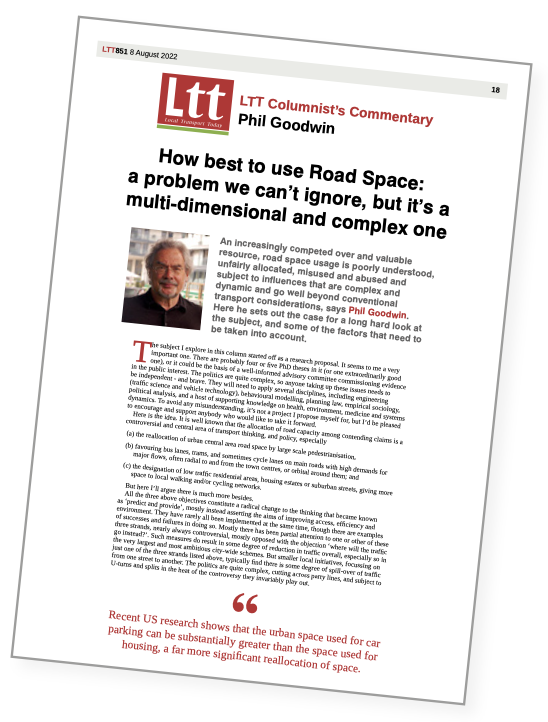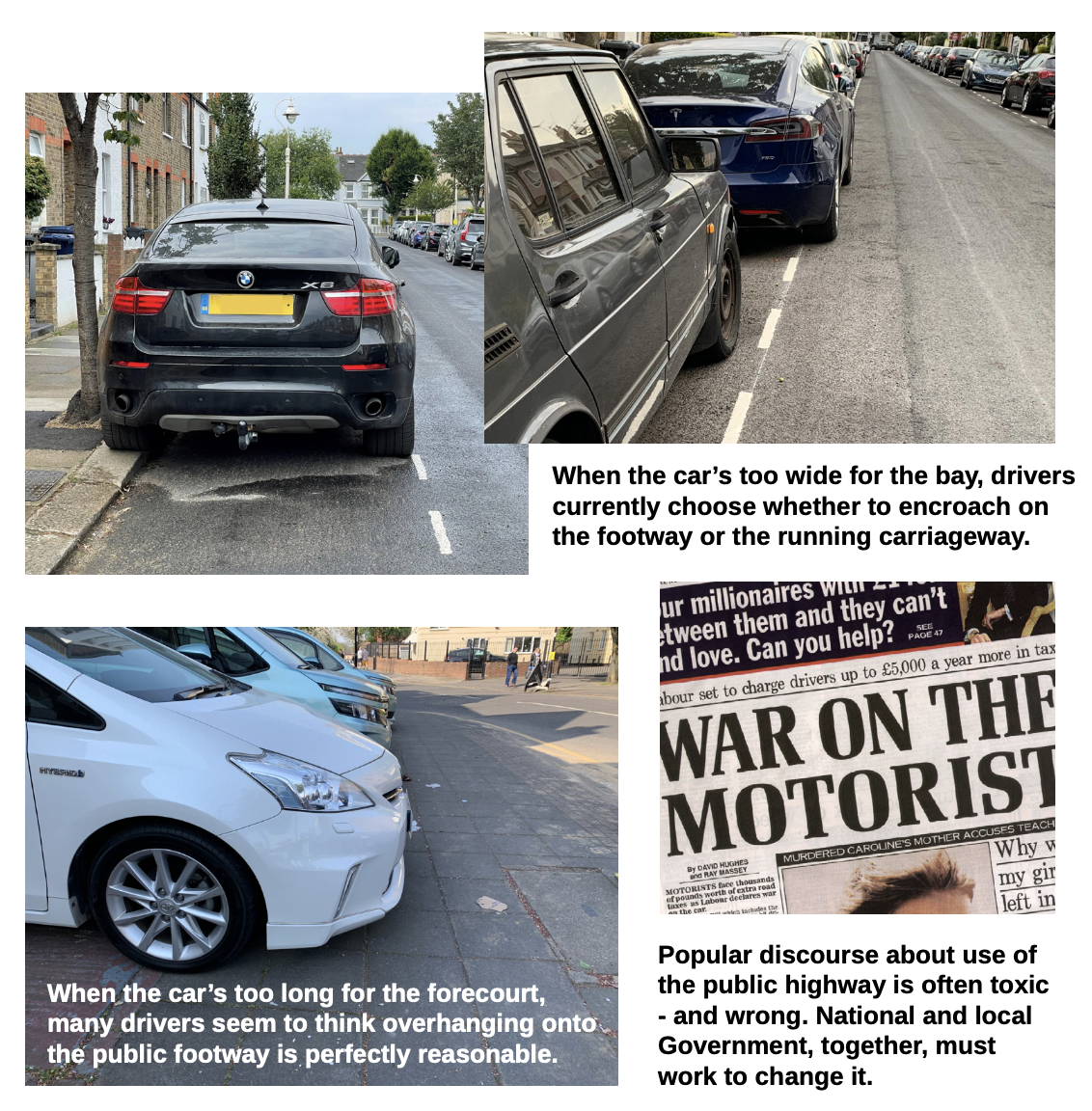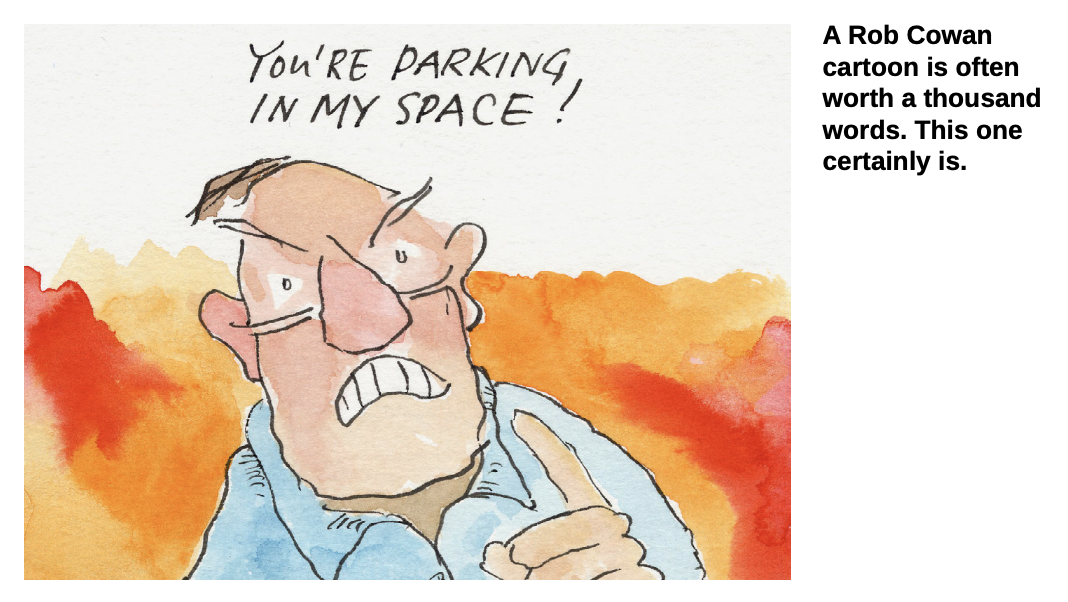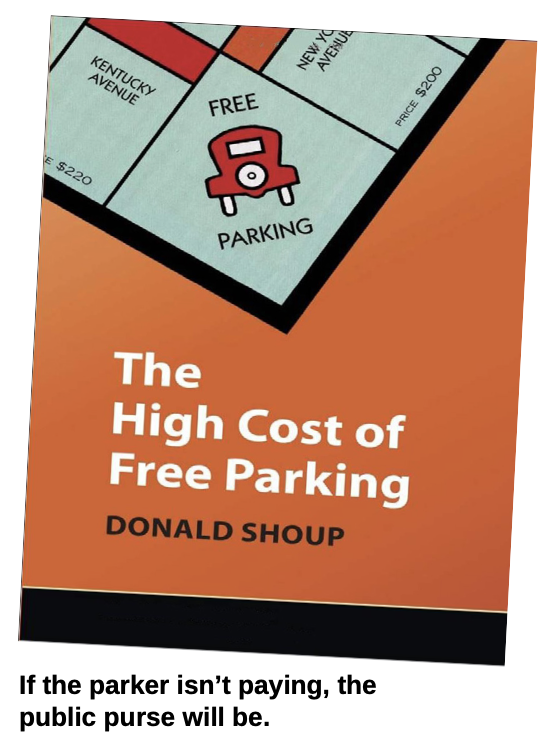TAPAS.network | 5 September 2022 | Commentary | John Dales
Street Space – a public asset from which we urgently need to get much greater value, for all

The increasingly important subject of efficient and equitable road space management has been addressed by more than one of our regular contributors. Here, further develops his thinking following Phil Goodwin’s contribution last month

A MONTH AGO (in LTT851), Professor Phil Goodwin wrote an excellent, thought-provoking piece entitled ‘How best to use Road Space’ describing the issue at stake as ‘a complex, multi-dimensional problem that we can’t ignore’. I was initially struck by the fact that, if you were to judge it only by its title and subtitle, this could well have been an article I might have written myself (although I’d have used the phrase ‘Street Space’!) Having then actually read the piece, I found – of course – that it was quite unlike my usual efforts in view of its rigour, breadth and depth.
Be that as it may, my own last LTT piece, about the need for more effective management of the increasing competition for space at the kerbside (LTT849), had covered some of the same ground. I’m thus hopeful that this is an indication that a head of steam is building towards necessary, long- overdue change. In seeking to do a little more towards this end, let me first attempt a brief summary of the proposal Phil set out.
He began by stating that’s there’s far more to the challenge of rethinking how street-space is used than is covered by the three types of initiative that are probably the most familiar (and controversial): central area pedestrianisation; bus, cycle or tram lanes on main roads; and filtering through traffic out of residential neighbourhoods. Phil then notes that, while such schemes may have the highest profile, there are other factors – some hidden in plain sight – that could actually be having a greater influence on how street space is used.
What I missed on first reading, perhaps because Phil’s way of expressing himself is too subtle for brains that work like mine, is that all these other factors relate to the increased use of space by motor vehicles and that, in aggregate, their effect may well be that cars, lorries and vans are now using more street space than previously, not less. This is despite the impression that many (if not most) people have that we’re in an era of space reallocation away from such vehicles – an impression aided and abetted by the click-bait headlines associated with the three more familiar types of intervention that Phil previously mentioned. The Shock! Horror! media coverage of the alleged dangers associated with cycles and e-scooters also creates the same impression, and of courses draws attention away from the five-a-day deaths on the UK’s roads - the vast majority of which are associated with driving errors.
In other words, if I read Phil’s thesis correctly, the popular notion of there being a ‘war on the motorist’ may be, in effect, a smokescreen hiding the fact that what we might call ‘guerrilla action’ is actually keeping motor vehicles in the ascendancy. This isn’t just about simple continuing traffic growth, although that remains a factor that some who celebrated the notion of ‘peak car’ may inadvertently overlook. Rather, Phil is drawing attention to the following ten trends, the net effect of which may be that ‘progress’ in street space allocation is by no means in the direction that current controversies would lead most to think.

I present these trends in simple list form, reworded somewhat, but with some of Phil’s words quoted to amplify.
-
Cars have been getting much bigger. “An increasing proportion of cars have a passenger car unit (PCU) factor of substantially greater than 1, which means that high levels of congestion or disruption can be experienced even if numbers of vehicles are stable or decreasing.”
-
Parking space dimensions have also been growing, formally and informally. “There are many urban roads which cannot support the wider new cars parked on both sides of the road without taking away lane capacity between them. That means that there is a choice between limiting the movement of other vehicles or having cars mounting the pavement and taking space away from pedestrians.”
-
The changing balance between space used for vehicles and that used for other purposes. “Parking near shops is often assumed to be favourable to business, though many small businesses seem to confuse their own desire for all day parking for the proprietor with multiple short-term parking for shoppers. Pavement space is also challenged by advertising installations, terminals and cables for electric vehicle charging, the machinery and supplies used for highway maintenance, and by signage, notices and signals.”
-
The reallocation of space requirements between different types of moving vehicle traffic. “The interaction of local and long-distance movement has been a long- term tension... Another shift in space has been between private cars and commercial traffic, especially that associated with on-line shopping and home deliveries.”
-
The reallocation of space requirements between different types of moving vehicle traffic. “The interaction of local and long-distance movement has been a long- term tension... Another shift in space has been between private cars and commercial traffic, especially that associated with on-line shopping and home deliveries.”
-
The evolving planning design of neighbourhoods. “A road space reallocation which has happened in the case of some traditional neighbourhoods is the conversion of the central yard from a rather safe playing area to use for car parking by the residents themselves... Planning regulations for new housing developments have provided for streets with more space to be allocated to car parking, limiting the amount available for other activities.”
-
The re-use of garages. “You have the increasing phenomenon of purpose-built garages converted into haphazard store rooms, while front gardens are concreted over to use as parking spaces. And sometimes used by vehicles which are so big that they do not even fit in the concreted garden and overlap the pavement.”
-
Entitlement beliefs about kerb-space. “There is a strong ‘folk-law’ approach to property ownership, where the stretch of kerb space spanning the frontage of a house is psychologically assumed to be the private property of the frontager. This may be contrasted with parklets, the use of the kerb-side frontage for alternatives to parking... The fundamental principle of use of the carriageway for purposes other than moving vehicles is identical, but the perceived legitimacy has been much more controversial.”
-
The arrival of intelligent and autonomous vehicles. “Industries and lobbyists have suggested changing arrangements for pedestrian access to cross the road, in the cause of avoiding people and vehicular conflicts and safety, e.g. by the reconstruction of pedestrian barriers, and in order to avoid the dilemma of requiring an automated vehicle to give precedence to pedestrians, or not to, both of which are viewed unfavourably.”
-
The defined and assumed rights of different users. “There are some explicit differential rights or practices for designated categories of users, including a suggested hierarchy in the new Highway Code, which is roughly based on vulnerability. But there are other hierarchies defined by law and social practice, for example those for emergency services, police, and disabled travellers. A less well specified hierarchy is the appropriation of special rights by the exercise of power, perceived entitlement, type of vehicle, or the assertiveness of drivers.”
As Phil says in relation to many of the above, the actual effects of these trends are probably larger than – and opposite too – the effects of any policy. Which is to say that, despite the prominence given to non-car travel within such national policy documents as Gear Change, Bus Back Better and Decarbonising Transport, other forces are at work – uncontrolled by policy – that, whether by accident or design, are working against sustainable transport objectives or, at the very least, consistently undermining them.
I have a rule than any list that runs to a nice, round number (like 5, 10 or 20) is either missing something important or adding something that doesn’t deserve to be there. In this regard, Phil says that he doubts the list above is exhaustive, and – as if to prove him right – you may have noted elsewhere in this issue a report on some recent research by the climate charity Possible. There’s no need for me to dwell on the details here, but the headline is that it costs vastly more to suspend a parking bay, so that it can be used for another purpose, than it does to use that space for private car parking.
The research, which looked at current practice in ten English cities, compared the weekly rate charged by local authorities for suspending a parking bay with the weekly cost of a parking permit. In three cities the latter cost was found to be nothing at all, while the cost in the other seven ranged from £0.04 per week (£2 per annum) to £4.33 per week (£225 per annum). These figures compare with weekly suspension costs ranging from £23.38 per week to £324.50 per week. The city-by-city ratios are eye-watering, putting aside the three where this task is complicated (but not rendered meaningless) by the fact you’re having to divide by zero.

Remember that, in the case of each city, we’re talking about a piece of the public highway of identical proportions and having the same landowner. The bias towards the use of this public asset for the storage of private property, as opposed to uses that might have greater public benefit, is stark. It should also be considered wholly unacceptable. And yet, without people like Possible doing some probing, it’s something that’s again hidden in plain sight, accepted as just ‘how things are’ because of a combination of our own instinctive biases (see Phil’s point 8 above) and, frankly, ignorance.
So, what now?
To what purpose, you may ask, have I used over 1,500 words in rehashing other people’s work? Well, firstly, I have done so simply by way of emphasis. Imitation is proverbially the sincerest form of flattery, and I’m very keen to ensure Phil’s thoughts on this issue have the widest possible audience. Secondly, I have tried to make some of what Phil wrote easier for people like me to digest. But also, thirdly, I want to take Phil’s thinking, Possible’s research, and my own collected thoughts on the matters at hand, and go in a different direction with it to that which Phil understandably advocates.
I’m not an academic, and it’s not my business to encourage others, as Phil did, to develop his thoughts as a research proposal. Apart from anything else, and as necessary and worthy as comprehensive research along those lines would be, I’m concerned about the timescales. Phil refers to his thoughts on street space reallocation trends as ‘just a hypothesis’, and goes on to say that ‘the key is to find the evidence’. My approach is to consider the essential plausibility of any given hypothesis, and if I find it passes muster, then I seek to do what I can (little as it might be) to get action taken.
In popular culture, from Yes, Minister to Star Wars, Episode I, the idea of setting up a committee of inquiry is lampooned as a means of kicking something important into the long grass, as a means of avoiding taking difficult decisions and/or action. What’s more, as successive reports by the Intergovernmental Panel on Climate Change (IPCC) have proved only too well, evidence itself – though vitally important – does not necessarily lead to the required steps being taken.
As the current Conservative party leadership process has clearly shown, important decisions by people with power and influence are often based far less on evidence than on the desire to appear to be a person with vision and authority, or on the desire to appeal to a particular constituency. Bearing in mind much of what our would-be PMs have said recently in trying to court the 160,000 or so people who constitute their immediate electorate, it might seem hopelessly optimistic to think that the people likely to be running the nation for the next year or more will be interested in developing and taking a wise, comprehensive and as evidence-based-as-possible approach to the issue of street space allocation. But it has to be worth a try, doesn’t it?
After all, the outgoing PM has been notorious for pursuing initiatives principally because of his personal belief that they were good things to do. There were the Garden Bridge, the ‘Boris Bus’, and a predilection for parties, that’s true. But there was also a turning of the transport policy tide towards cycling and walking. The latter does not excuse the former, and this is not about trade-offs. My point is simply that there may be value in asserting the need for change in some field – and it might be road space allocation – and that the use of appealing arguments to that end might have as great a chance of success as the use of copious evidence. Besides, it has to be ‘both/and’, not ‘either/or’, surely.

As for what the most appealing arguments might be, concerning the hardly headline-grabbing topic of road or street space allocation, my focus has been increasingly on the fact that the public highway must be increasingly seen and understood – not least by highway authorities themselves – as an extraordinarily valuable public asset. The recent Possible research shows that we have no consistent basis for making such valuations, and also confirms what is obvious to most casual observers: most of the time highway authorities either give their street-space away or charge well under what would be considered the market rate. The title of the American author Donald Shoup’s book, The High Cost of Free Parking, summarises the issue very well.
For whatever reasons, we currently find ourselves in a situation where, in practice, the phrase ‘public highway’ seems never to be understood as affirming the fact that it is the highway authority’s precious property - held on our behalf - not just its legal responsibility. Over many years, this has led to the development of a culture in which private individuals consider it reasonable to be aggrieved at being charged anything for the use of a property owned by someone else. There is very limited acceptance or acknowledgement that the highway authority has a vital and legitimate role in stewarding a public asset for the wider public benefit. As Phil notes, many people even appear to consider that the street space outside their home is their own.
Local authorities need to develop, assert and clearly communicate a sense of their true ownership of the kerbside, and of the common value associated with that property. The Government needs to get in on this act, too, because of the cost-of-living crisis, not despite it. All other things being equal, greater public revenues from use of the public highway will lead to lower Council Tax bills, and could subsidise public transport; while the increased private costs will fall more lightly on the less well-off, especially those who do not own cars. In short, the public highway should properly be given an appropriate market asset value, and suitable framework for its most beneficial use.
This is by no means just a matter of income generation, however, rather it is a matter of adopting a properly business-like approach to the care and management of a public good. Viewed this way, the difficult and friendless task of enforcing traffic regulations and collecting fines can be turned into a fair and transparent system of ‘Charging for a Service’. Delivery and logistics companies, which routinely accept fines as an inevitable cost of going about their business, would likely consider a more predictable and open system of charges a distinct improvement on the status quo. Similarly, a system of rising charges for longer parking stays, rather than a set rate for a specific time followed by a fixed penalty for over-running, could well find support amongst the general public, especially if the wider benefits to them were effectively communicated.
Almost all the objections that individual vehicle users raise concerning their use of street space (whether moving or static) – from the experience of congestion to cost – exemplify ‘the tragedy of the commons’. By assigning and asserting a proper market value to the public highway, and enabling others – from local residents to businesses – to understand how they can benefit from its better stewardship, local authorities and the Government have a real opportunity to transform the economics, the politics and the equity of street space allocation for the common good.
Isn’t that something truly worth grasping? Let’s make a start to doing so.
NB Professor Phil Goodwin’s previous article on the same subject is available to read here.
John Dales is a streets design adviser to local authorities around the UK, a member of several design review panels, and one of the London Mayor’s Design Advocates. He’s a past chair of the Transport Planning Society, a former trustee of Living Streets, and a committee member of the Parliamentary Advisory Council for Transport Safety. He is director of transport planning and street design consultancy Urban Movement.
This article was first published in LTT magazine, LTT852, 5 September 2022.
You are currently viewing this page as TAPAS Taster user.
To read and make comments on this article you need to register for free as TAPAS Select user and log in.

Log in